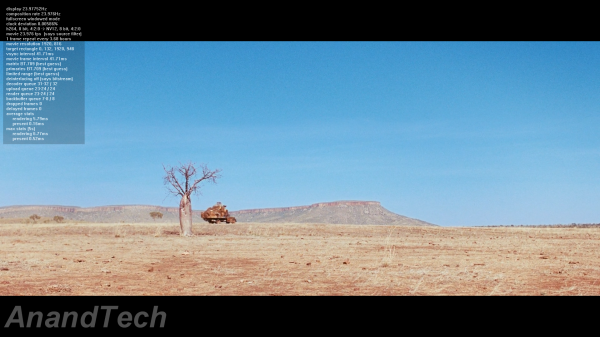AMD's Trinity : An HTPC Perspective
by Ganesh T S on September 27, 2012 11:00 AM ESTMany users tend to avoid Intel GPUs because of the absence of accurate video output refresh rates. Intel has still not come out with their promised update to bring 23.976 Hz refresh to Ivy Bridge. AMD has historically been able to provide quite accurate refresh rates while NVIDIA gives users the ability to make fine-grained adjustments to their settings.
How does Trinity fare? The short story is that the display refresh rate is not as accurate as we would like. However, it is still much better than Intel's setting. NVIDIA cards, when configured correctly, can probably provide better accuracy. We are not sure whether this is an issue specific to the Asus board, or it is a problem with the drivers / processor's video output itself. Setting the display refresh rate to 23 Hz yields 23.977 Hz, as shown below.
Other refresh rates also suffer similar problems The gallery below shows some of the other refresh rates that we tested.
An interesting point to note here is that AMD is able to drive 25 Hz, 29 Hz and 30 Hz refresh rates on the Sony KDL46EX720 through the Pioneer Elite VSX-32. In the same setup, NVIDIA and Intel don't present these settings in the progressive format. That said, both Intel and NVIDIA offer 50 Hz, 59 Hz and 60 Hz settings which are exactly double of the above settings (Clarification: 29 Hz in the control panel corresponds to a refresh rate of 29.97 Hz, and 59 Hz in the panel corresponds to a refresh rate of 59.94 Hz).
It would be nice to have more control over the display refresh rate similar to what NVIDIA provides. That would help users fine-tune their settings in case the out of the box behaviour doesn't match the user's expectations.

















49 Comments
View All Comments
Beenthere - Thursday, September 27, 2012 - link
There is an appropriate CPU/APU model for every budget these days. Virtually any current model APU/CPU will perform just fine for 98% of consumers. Most consumers buy what fits their needs and budget, not the over priced, over hyped top-of-the-line models.AMDs new Trinity APUs and Vishera desktop FX processors offer more performance for less, which is good for consumers.
silverblue - Thursday, September 27, 2012 - link
We don't know about Vishera, not yet anyway. We don't know what the improvements over Bulldozer will yield as a whole, only what a couple of benchmarks showed in a brief Toms comparison between Trinity and Zambezi. There are plenty of scenarios to consider.Beenthere - Thursday, September 27, 2012 - link
Yes some of us do know the results... Comparing Trintiy to Vishera is incorrect. Vishera is to be compared to Zambezi.AMD has hit their projected 10-15% gains for Vishera compared to Zambezi. Some people already know the results but the NDA doesn't expire for a few weeks so they can't print them yet. Most folks will be happy with Vishera except the haters.
silverblue - Thursday, September 27, 2012 - link
I'd find it hard to believe you were personally under NDA (please prove me wrong). I also believe the gains were per clock, which should theoretically, given the assumption you stated, result in a slightly larger performance gap between the 8150 and the 8350 as the latter has a higher base clock and is more likely to hit max turbo speed.Like I said though, two benchmarks in the public domain aren't gospel, regardless of whether we're comparing Vishera OR Trinity to Zambezi. Remember that L3 cache doesn't always help, but when it does, the gains can be significant, meaning the A10-5800K could occasionally be outperformed by a similarly clocked 41x0 CPU, but the flip side is that it could occasionally perform on par with a similarly clocked 43x0 CPU.
Death666Angel - Thursday, September 27, 2012 - link
"AMD was a little late in getting to the CPU - GPU party. Their first endeavour, the Llano APU"Aren't Zacate and Ontario APUs? They were released in 01/2011, half a year before Llano. Or aren't you counting low power APUs? :)
Thanks for the article!
Death666Angel - Thursday, September 27, 2012 - link
Mea culpa, didn't read the comments before posting my own. :) Disregard.EnzoFX - Thursday, September 27, 2012 - link
What's the big deal with 4k at THIS moment? There are no 4k tv's out are there? By the time they're out, or by the time they're actually affordable by a decent amount of consumers, we would have several generations of new apu's.Denithor - Tuesday, October 2, 2012 - link
http://www.lg.com/us/tvs/lg-84LM9600-led-tvAllio - Thursday, September 27, 2012 - link
These HTPC-perspective articles are consistently some of the most useful and interesting content that AT puts up. As far as I can tell, there really aren't any other tech sites that delve this deep into this kind of functionality - most reviews settle for playing a 1080p Bluray and posting a screenshot of the CPU usage in task manager. While it may only be a relatively small audience for who this stuff is relevant, we are a very interested audience, and I personally appreciate every detail and statistic included. Thanks Ganesh!wharris1 - Thursday, September 27, 2012 - link
At this point, it seems 4k is more marketing hype. I'll link this article: http://reviews.cnet.com/8301-33199_7-57491766-221/...For the typical anandtech readers (probably much more technically gifted than me) I also recall reading a similar article/post on avsforums explaining that for any display size <~100 inches, the 4k standard is hard to justify. Also, while I know that future proofing is sound, there is very little content or ability to play back said content at that resolution. As a previous poster mentioned, by the time 4k becomes a standard, the current platforms will seem antiquated. Anyway, Anandtech is the best tech site around by far; read it every morning.